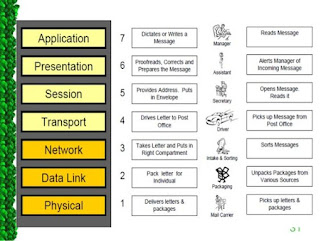OSI LAYER MODEL
OSI or Open System Interconnection layer
model is a model created by International Standardization of Organization (ISO)
for communication system to communicate with a standard protocol. When the
student uses their computer to access Ulearn System, the data flows from
application layer, presentation, session, transport, network, data link and
physical layer.
Application layer
The application layer is
responsible for providing service to the user. It is used by the end user
software which is for example the web browser. It provides protocol that allow
the browser to send and receive information and present meaningful data to
user. Protocol example are Hypertext Transfer Protocol (HTTP) and File
Transfer Protocol (FTP).
Presentation layer
The
presentation layer is responsible for the syntax and semantics of the
information exchanged between two systems. It defines how two devices
should encode, encrypt, and compress data so it is received correctly on the
other end. The encoding is to make sure that the two devices can communicate.
An encryption is to make the privacy is protected. And the compression is to
improve the speed and efficiency of communication by minimizing the amount of
data that will be transferred.
Session layer
The
session layer is responsible for maintains, establishes, and synchronizes the
interaction between communicating systems. It will open long enough for data to
transfer between sender and receiver and close once it’s done to ensure no
resource is waste. The synchronization is like a checkpoint in a data. Whenever
the transfer is interrupted, it will continue from the last checkpoint.
Transport layer
The
transport layer is responsible for delivery of a message from one process to
another. Data is break into segment before sending to receiver. The receiver
will reassemble the segment into proper data before sent to session layer. The
transport layer carries out flow control, sending data at a rate that matches
the connection speed of the receiving device, and error control, checking if
data was received incorrectly and if not, requesting it again.
Network layer
The
network layer is responsible for the delivery of packets from the original
source to the final destination. The network layer breaks up segments from the
transport layer into smaller units, called packets, on the sender’s device, and
reassembling these packets on the receiving device. Network layer will use
routing to find the best path to the destination.
Data link layer
The
data link layer is responsible for transmitting frames from one node to the
next. data link layer facilitates data transfer between two devices on the same
network (Utem Campus Network). Data link layer breaks packet into frame. There
are two parts in this layer which is Logical Link Control (LLC), which
identifies network protocols, performs error checking and synchronizes frames,
and Media Access Control (MAC) which uses MAC addresses to connect devices and
define permissions to transmit and receive data.
Physical layer
The
physical layer is responsible for transmitting individual bits from one node to
the next. In this layer data is converted into bit of stream (string of 0 and
1) while taking care of bit rate control. The synchronization of bits means
that both devices need to agree on signal convention. It also responsible for
the physical cable or wireless connection between network nodes.
When the data arrive at Ulearn System it will go in reverse direction which is from physical to application layer.







